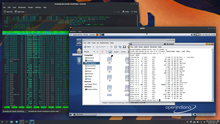
Back محاكاة افتراضية Arabic Виртуализация Bulgarian ভার্চুয়ালাইজেশন Bengali/Bangla Virtualizacija (računarstvo) BS Virtualització Catalan مەجازیکردن CKB Virtualizace Czech Virtualisering Danish Virtualisierung (Informatik) German Εικονικοποίηση Greek
In computing, virtualization (v12n) is a series of technologies that allows dividing of physical computing resources into a series of virtual machines, operating systems, processes or containers.[1]

Virtualization began in the 1960s with IBM CP/CMS.[1] The control program CP provided each user with a simulated stand-alone System/360 computer.
In hardware virtualization, the host machine is the machine that is used by the virtualization and the guest machine is the virtual machine. The words host and guest are used to distinguish the software that runs on the physical machine from the software that runs on the virtual machine. The software or firmware that creates a virtual machine on the host hardware is called a hypervisor or virtual machine monitor.[2] Hardware virtualization is not the same as hardware emulation. Hardware-assisted virtualization facilitates building a virtual machine monitor and allows guest OSes to be run in isolation.
Desktop virtualization is the concept of separating the logical desktop from the physical machine.
Operating-system-level virtualization, also known as containerization, refers to an operating system feature in which the kernel allows the existence of multiple isolated user-space instances.
The usual goal of virtualization is to centralize administrative tasks while improving scalability and overall hardware-resource utilization.
- ^ a b Rodríguez-Haro, Fernando; Freitag, Felix; Navarro, Leandro; Hernánchez-sánchez, Efraín; Farías-Mendoza, Nicandro; Guerrero-Ibáñez, Juan Antonio; González-Potes, Apolinar (2012-01-01). "A summary of virtualization techniques". Procedia Technology. The 2012 Iberoamerican Conference on Electronics Engineering and Computer Science. 3: 267–272. doi:10.1016/j.protcy.2012.03.029. ISSN 2212-0173.
- ^ Turban, E; King, D.; Lee, J.; Viehland, D. (2008). "19". Electronic Commerce A Managerial Perspective (PDF) (5th ed.). Prentice-Hall. p. 27.